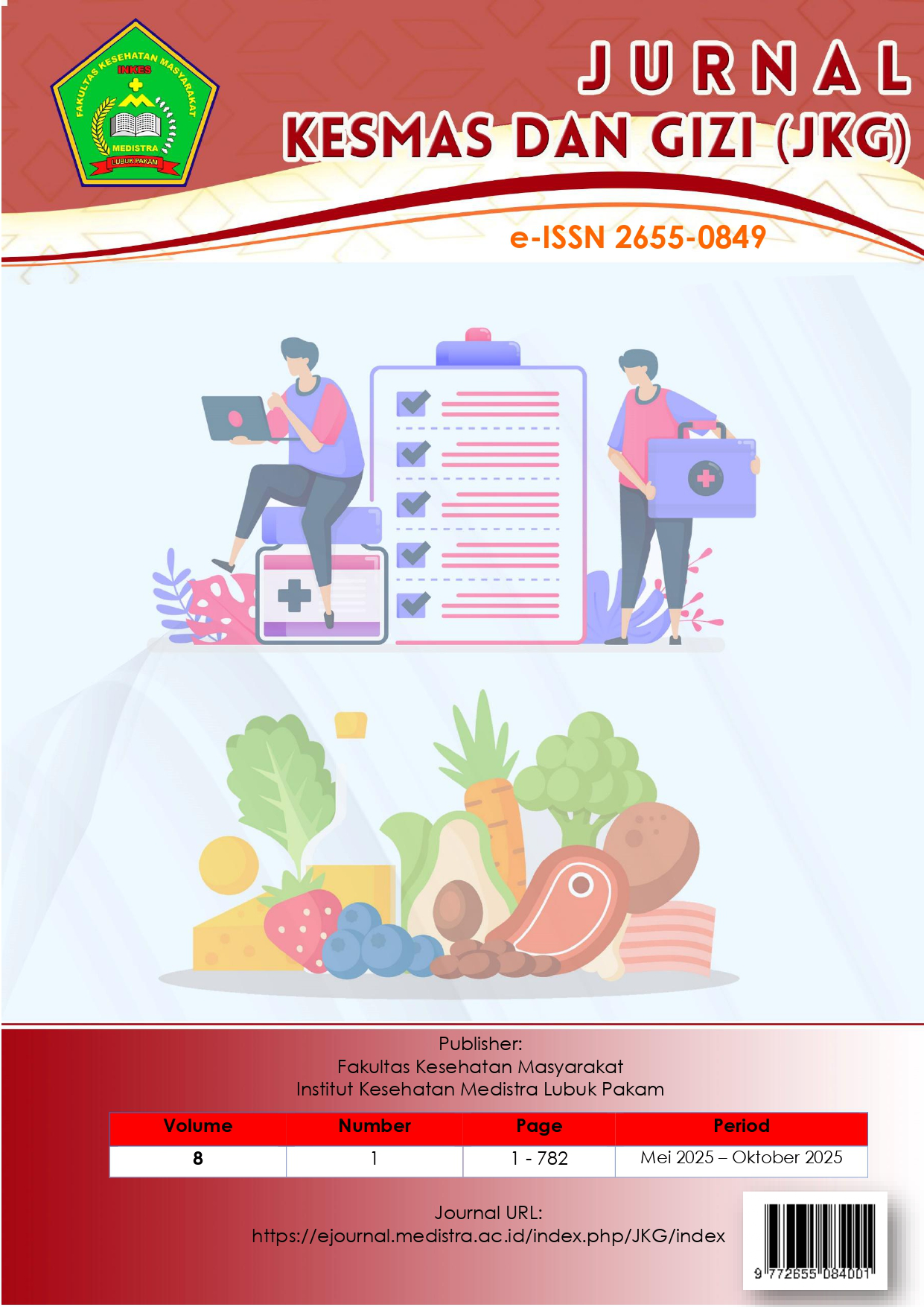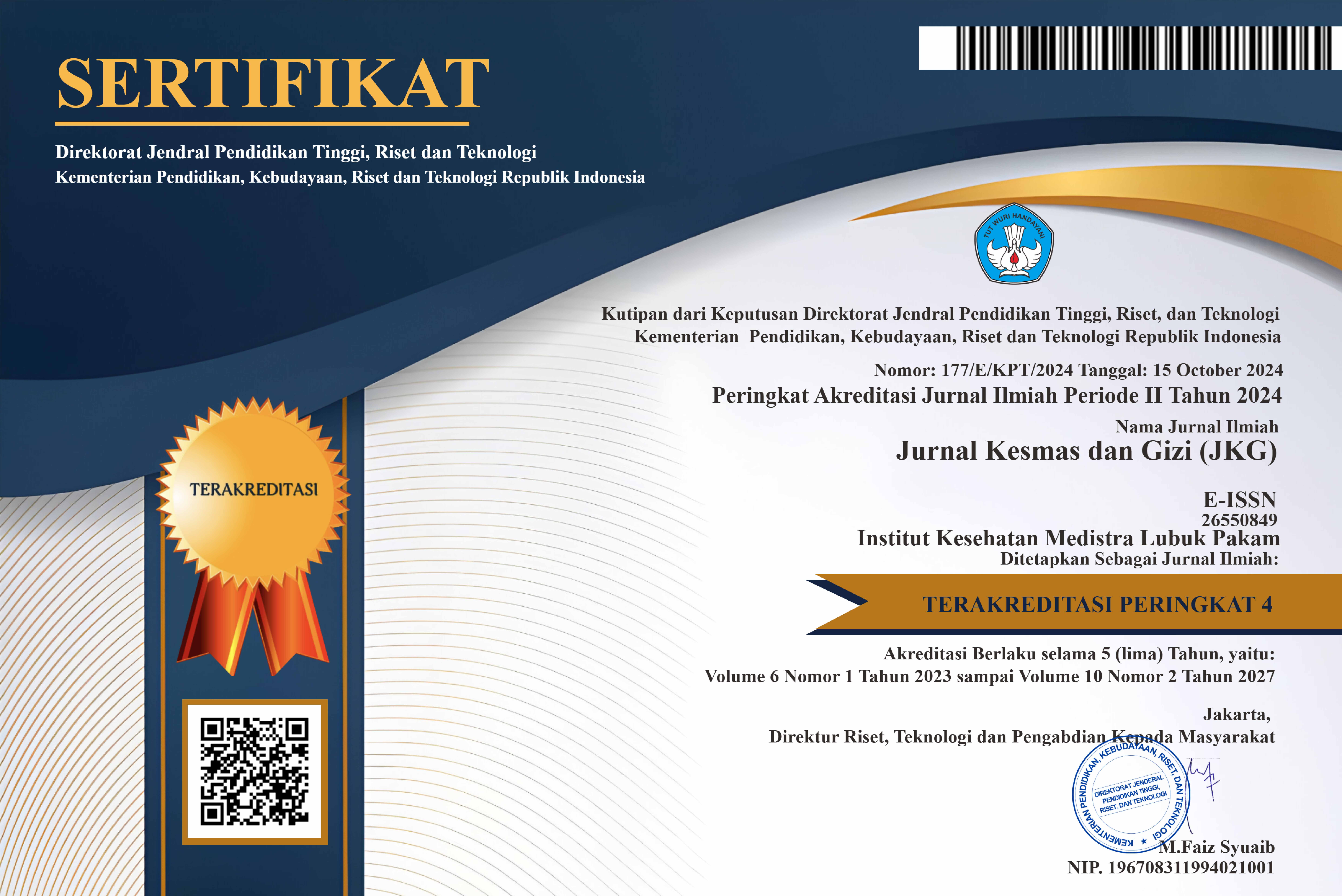The Nutrition Care Process in Hospitalized Patients with Chronic Kidney Disease Stage V, Pancytopenia, and Hypertension
DOI:
https://doi.org/10.35451/f83acv69Keywords:
Penyakit Ginjal Kronis, Diet, Proses Asuhan Gizi TerstandarAbstract
Patients with chronic kidney disease undergoing hemodialysis require proper nutritional management to prevent malnutrition. This is because the hemodialysis process can cause protein loss and energy imbalance. Objectives the aim of this research is analyzing the Standardized Nutrition Care Process carried out in hospitalized patients with CKD at Moewardi Hospital Surakarta. This study is a descriptive study with case studies. Data were collected through patient interviews and analysis of medical records. Monitoring and evaluation of nutritional care were conducted over a period of 3 days. Indicators used for monitoring included anthropometric data, biochemistry, physical clinical data, and food intake through a 24-hour recall form. Results, a low-sodium dialysis diet (LS) III was prescribed to the patient, with the Schofield formula being used to determine nutrition requirements. The required energy was 2102.64 kcal, with 69.44 g of protein, 70.08 g of fat, and 298.54 g of carbohydrates. The daily limit of sodium was set at 1-2 mEq/KgBW because of hypertension and edema. Soft food was provided three times a day for main meals and two times a day for snacks. After three day monitoring period, there was an increase in patient intake however, it remained below the target level of 70%. In this case, the patient's intake increased on day 2, but on day 3 there was a decrease in intake due to the patient's unstable condition. As a result, the interventions carried out had to be adjusted to align with the patient's condition.
Downloads
References
[1] WHO. Noncommunicable diseases. World Health Organization. 2024. Noncommunicable diseases. World Health Organization. https://www.who.int/newsroom/ fact-sheets/detail/noncommunicable-diseases.
[2] IRR. 3 th Annual Report of Indonesian Renal Registry 2020 2020. www.indonesianrenalregistry.org.
[3] SKI. Survei Kesehatan Indonesia Dalam Angka. 1-965: Kementrian Kesehatan Republik Indonesia; 2023.
[4] RISKESDAS. Riset Kesehatan Dasar Nasional 2018. Badan Penelitian dan Pengembangan Kesehatan; 2018.
[5] Rahmadani AF, Rahmi N, Nadira P, Hidayah S, Kisty TAH. Analisis Survival Terhadap Pasien Penderita Gagal Ginjal Menggunakan Metode Kaplan Meier. Indones Counc Prem Stat Sci 2023;2:1–13. https://doi.org/10.24014/icopss.v2i1.25323.
[6] Ningsih SA, Rusmini H, Purwaningrum R, Zulfian Z. Hubungan Kadar Kreatinin dengan Durasi Pengobatan HD pada Penderita Gagal Ginjal Kronik. J Ilm Kesehat Sandi Husada 2021;10:202–7. https://doi.org/10.35816/jiskh.v10i1.581.
[7] Satti Y, Mistika S, Imelda L. Faktor-Faktor yang Mempengaruhi Status Gizi Pasien Hemodialisa di Rumah Sakit Stella Maris Makassar. J Keperawatan Florence Nightingale 2021;4:1–8. https://doi.org/10.52774/jkfn.v4i1.54.
[8] Anasulfalah H, Handayani RT, Widiyanto A, Kurniawan HD, Atmojo JT, Mubarok AS, Putri SI, Duarsa AB, Anulus A. Gambaran Kualitas Hidup Pasien Dengan Chronic Kidney Disease Yang Menjalani Hemodialisa Di Rsud Dr. Moewardi. Avicenna: Journal of Health Research. 2022 Oct 22;5(2).
[9] Ekaputri GJ, Khasanah TA. Hubungan Asupan Energi dan Protein Terhadap Status Gizi Pasien Penyakit Ginjal Kronik Dengan Hemodialisa. J Gizi Dan Kuliner J Nutr Culin 2022;2:16–23. https://doi.org/10.24114/jnc.v2i2.37532.
[10] Sanjaya AAGB, Santhi DGDD, Lestari AAW. Gambaran Anemia Pada Pasien Penyakit Ginjal Kronik Di RSUP Sanglah Pada Tahun 2016. E-J Med Udayana 2019;8:1–6. https://ojs.unud.ac.id/index.php/eum/article/view/51116.
[11] Ratnasari D. Hubungan Lama Hemodialisa Dengan Status Nutrisi Pada Pasien Gagal Ginjal Kronik Di Ruang Hemodialisa. J Sk Keperawatan 2020;6:16–23. https://doi.org/10.35974/jsk.v6i1.2321.
[12] Nasar SS, Suharyati Djoko, SA. Budi Hartati, Y. Endang Budiwiarti, editors. Penuntun Diet Anak Edisi ke-3. Jakarta: FKUI; 2017.
[13] Suharyati, Kresnawan T, Sunarti, Hudayani F, Darmarini F, S.A. Budi H, editors. Penuntun Diet dan Terapi Gizi : Persatuan Ahli Gizi Indonesia dan Asosiasi Dietisien Indonesia. Jakarta: Buku Kedokteran EGC; 2019.
[14] Riduansyah M, Zulfadhilah M, Annisa A. Gambaran Tingkat Kesadaran Pasien Cedera Kepala Menggunakan Glasgow Coma Scale (GCS). J Persat Perawat Nas Indones JPPNI 2021;5:137–45. https://doi.org/10.32419/jppni.v5i3.236.
[15] Kemenkes. Hipertensi Disebut sebagai Silent Killer, Menkes Budi Imbau Rutin Cek Tekanan Darah 2023. https://www.kemkes.go.id/id/rilis-kesehatan/hipertensi-disebut-sebagai-silent-killer-menkes-budi-imbau-rutin-cek-tekanan-darah (accessed May 26, 2024).
[16] Susilistyowati A. Pemeriksaan tanda-tanda Vital. Akademik Keperawatan Kerta Cendekia Sidoarjo; 2018.
[17] Purnawati ID. Status Nutrisi Pada Anak Dengan Gangguan Ginjal Kronis. Bul Kesehat Publ Ilm Bid Kesehat 2021;5:73–82. https://doi.org/10.36971/keperawatan.v5i2.94.
[18] Sahang SW. Penerapan Asuhan Keperawatan Pada Pasien Tn. H Dengan Gagal Ginjal Kronik Dalam Pemenuhan Kebutuhan Cairan dan Elektrolit Di RSUD Labuang Baji Makassar. J Media Keperawatan Politek Kesehat Makassar 2018;09:1–18. https://doi.org/10.32382/jmk.v9i1.68.
[19] Arianti A, Rachmawati A, Marfianti E. Karakteristik Faktor Risiko Pasien Chronic Kidney Disease (CKD) Yang Menjalani Hemodialisa di RS X Madiun. Biomedika 2020;12:36–43. https://doi.org/10.23917/biomedika.v12i1.9597.
[20] Siregar PA, Simanjuntak SFS, Ginting FH, Tarigan S, Hanum S, Utami FS. Physical Activity, Consumption of Salty Foods and the Occurrence of Hypertension in Coastal Communities in Medan City. J Ilm Kesehat JIKA 2020;2:1–8. https://doi.org/10.36590/jika.v2i1.34.
[21] Panggabean M. Nutrisi Pasien Anak dengan Chronic Kidney Disease (CKD). Cermin Dunia Kedokt 2022;49:320–6. https://doi.org/10.55175/cdk.v49i6.240.
[22] McAlister L, Pugh P, Greenbaum L, Haffner D, Rees L, Anderson C, et al. The dietary management of calcium and phosphate in children with CKD stages 2-5 and on dialysis—clinical practice recommendation from the Pediatric Renal Nutrition Taskforce. Pediatr Nephrol Berl Ger 2020;35:501–18. https://doi.org/10.1007/s00467-019-04370-z.
[23] Sherly, DAndika Putri D, Siregar A, Yuliantini E. Asupan Energi, Protein, Kalium dan Cairan dengan Status Gizi (SGA) Pasien GGK yang Menjalani Hemodialisa. Ghidza J Gizi Dan Kesehat 2021;5:211–20. https://doi.org/10.22487/ghidza.v5i2.200.
[24] Bernal A, Zafra MA, Simón MJ, Mahía J. Sodium Homeostasis, a Balance Necessary for Life. Nutrients 2023;15:395. https://doi.org/10.3390/nu15020395.
[25] Schaffer S, Kim HW. Effects and Mechanisms of Taurine as a Therapeutic Agent. Biomol Ther 2018;26:225–41. https://doi.org/10.4062/biomolther.2017.251.
[26] Nishioka N, Luo Y, Taniguchi T, Ohnishi T, Kimachi M, Ng RC, et al. Carnitine supplements for people with chronic kidney disease requiring dialysis. Cochrane Database Syst Rev 2022;2022:CD013601. https://doi.org/10.1002/14651858.CD013601.pub2.
[27] Riani AP. Hubungan asupan enegi dan protein dengan status gizi berdasarkan %LILA menurut umur pada pasien Chronic Kidney Disease on Hemodialisis di RSUD Dr. Saiful Anwar Malang. J Labora Med 2019;3:15–22. https://doi.org/10.26714/jlabmed.3.1.2019.15-22.
[28] Alvin K, Subagio Sutanto Y, Dwi Susanto A, editors. Panduan Umum Praktik Klinik Penyakit Patu dan Pernapasan. Jakarta: Perhimpunan Dokter Paru Indonesia; 2021.
Downloads
Published
Issue
Section
License
Copyright (c) 2025 Herviana, M.Gz, Kiki Rizky Ananda, S.Gz., M.Gz, Eka Rusliana, M.Gz, Wiwik Ekorinawati, M.Gz.RD, Helmi Susanti Simamora, M.Gz

This work is licensed under a Creative Commons Attribution 4.0 International License.
Copyright in each article is the property of the Author.


























